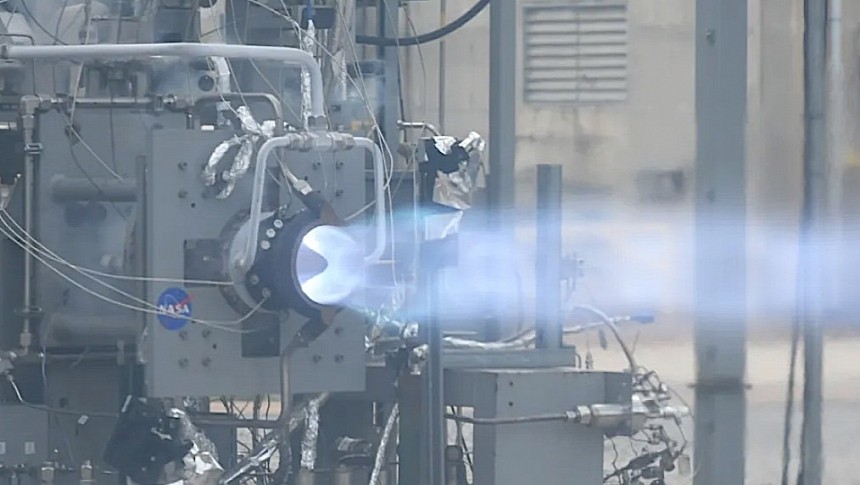If we are to truly become a solar system-wide civilization, we really need to rethink the means of propulsion that are currently taking us off our own planet. After all, current rocket engines are more than enough to send rovers to Mars, but by no means are they suited to support crewed missions and their need for more cargo.
One avenue of research for NASA in this field is the rotating detonation engine. Using detonation waves resulting from the explosion of fuel and oxidizer, this type of device is self-sustaining, and the resulting pressure waves, traveling at supersonic speeds, are more than enough to provide the required thrust.
NASA started testing such a design, called RDRE (Rotating Detonation Rocket Engine), in the summer of last year. Back then, the rocket engine's first hot fire test saw it burn for close to one full minute and generate 4,000 pounds of thrust.
More tests followed since, with the RDRE amassing about ten minutes of operational time, but never going past the thrust threshold it reached in 2022. Until now, that is, as the American space agency announced a new milestone was reached, both in terms of power and duration.
Somewhere on the premises of the Marshall Space Flight Center in Huntsville, Alabama, the RDRE was fired continuously for a total of 251 seconds (that's four minutes and 11 seconds), during which time it reached power levels of 5,800 pounds of thrust.
According to the engineers working on the project this kind of sustained burn is what's expected from a rocket engine during the touchdown of a lander on some distant world, or the equivalent of a deep space burn that would put a spacecraft on a course for the Moon or Mars.
The test apparently ended with no issues, but its main goal was not necessarily about power or duration. Engineers are trying to determine the best ways to scale the technology to be suitable for different thrust classes, meaning they're trying to make the RDRE a potentially game-changing technology for several kinds of missions, going from landers to upper stages or even deceleration engines to slow a spacecraft enough for it to be able to safely land on Mars.
There is no public timeline about when a rotating detonation engine could be deployed on a spacecraft, but its advantages go well beyond more thrust. Such a design has proven it also needs less fuel to operate, allowing a spacecraft to carry more payload instead.
Last time NASA gave us an update on the technology it was talking about making an RDRE unit that plays in the 10,000-pound class and that can be reused. No further update was given on that plan with this new announcement.
A short video of the rocket engine in action can be seen below. You should be warned, though, the scream the thing lets out as it's fired up is truly out of this world.
NASA started testing such a design, called RDRE (Rotating Detonation Rocket Engine), in the summer of last year. Back then, the rocket engine's first hot fire test saw it burn for close to one full minute and generate 4,000 pounds of thrust.
More tests followed since, with the RDRE amassing about ten minutes of operational time, but never going past the thrust threshold it reached in 2022. Until now, that is, as the American space agency announced a new milestone was reached, both in terms of power and duration.
Somewhere on the premises of the Marshall Space Flight Center in Huntsville, Alabama, the RDRE was fired continuously for a total of 251 seconds (that's four minutes and 11 seconds), during which time it reached power levels of 5,800 pounds of thrust.
According to the engineers working on the project this kind of sustained burn is what's expected from a rocket engine during the touchdown of a lander on some distant world, or the equivalent of a deep space burn that would put a spacecraft on a course for the Moon or Mars.
The test apparently ended with no issues, but its main goal was not necessarily about power or duration. Engineers are trying to determine the best ways to scale the technology to be suitable for different thrust classes, meaning they're trying to make the RDRE a potentially game-changing technology for several kinds of missions, going from landers to upper stages or even deceleration engines to slow a spacecraft enough for it to be able to safely land on Mars.
There is no public timeline about when a rotating detonation engine could be deployed on a spacecraft, but its advantages go well beyond more thrust. Such a design has proven it also needs less fuel to operate, allowing a spacecraft to carry more payload instead.
Last time NASA gave us an update on the technology it was talking about making an RDRE unit that plays in the 10,000-pound class and that can be reused. No further update was given on that plan with this new announcement.
A short video of the rocket engine in action can be seen below. You should be warned, though, the scream the thing lets out as it's fired up is truly out of this world.







